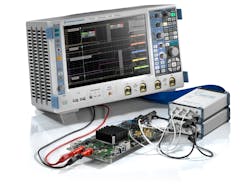Special Report: High-end oscilloscopes (.PDF Download)
Much like cars, home appliances, and consumer gadgets, the market for oscilloscopes has traditionally been divided into mainstream instruments and those considered high-end. There’s no industry-standard definition of either, but in a general sense, mainstream oscilloscopes have everything needed to get the job done for most applications, whereas high-end scopes offer more advanced and sophisticated features for precise measurements, often for industrial or research applications.
The definition of “high-end” likely differs from one test instrumentation vendor to the next, which can make classifying a scope as mainstream or high-end a tricky endeavor. Some might base their high-end standard on a certain price threshold; some might consider certain features a scope must have. In recent years, some features traditionally reserved for top-of-the-line scopes have been making their way into mainstream scopes, blurring the line even further. Another factor in oscilloscopes’ classification is the fact that vendors are making their instruments increasingly customizable, with some leading oscilloscopes at a price point in upwards of $50,000 if it has all the available bells and whistles equipped.
All-in-all, it’s a grey area, but one worth examining.
